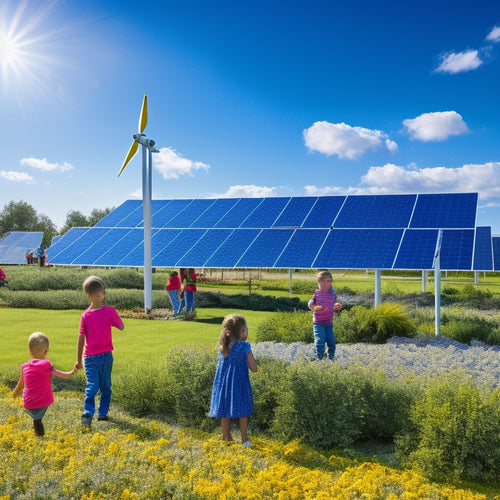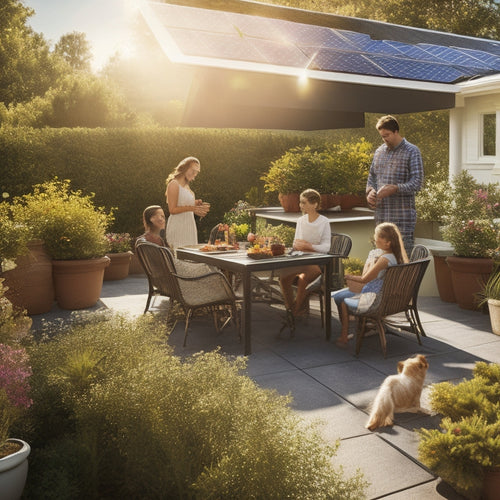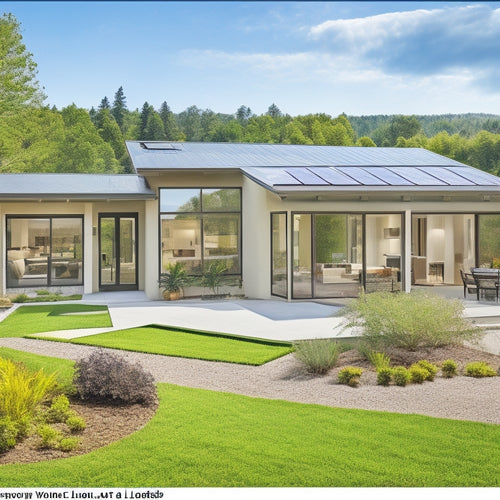
10 Key Factors in Solar House Installation Costs
Share
When determining your solar house installation costs, you'll need to take into account 10 key factors. Your system's size and quality, as well as panel efficiency and type, greatly impact costs. Roof size and orientation also play an essential role, as do inverter type and quality, and mounting and racking systems. Additionally, the installation company and labor costs, local building codes and permits, and electrical panel upgrades needed all factor in. Location and regional incentives, as well as state tax credits, can also affect your overall cost. Understanding these factors will help you make informed decisions - and there's more to investigate to guarantee a successful solar installation.
Key Takeaways
- System size and quality significantly influence solar installation costs, with larger systems providing more power output but at a higher cost.
- High-efficiency solar panels and high-quality inverters can increase energy production and lifespan, but also raise upfront costs.
- Roof size, orientation, and complexity affect installation costs, with larger roofs and complex layouts requiring more materials and labor.
- Installation company and labor quality are critical, with skilled professionals and experienced companies ensuring successful installations and impacting overall cost.
- Local building codes, permits, and regulatory compliance can add to installation costs, with permit fees ranging from $500 to $2,000 based on location.
System Size and Quality
When it comes to solar house installation costs, system size and quality play an essential role in determining the final price tag. You'll need to evaluate your energy needs and how they impact the system design. A larger system will generally cost more, but it'll also provide more power.
The quality of the system components, such as panels and inverters, also affects the cost. High-efficiency panels, for instance, may be more expensive upfront but can provide more power per hour of sunlight.
To determine the right system size for your needs, you'll need to assess your energy usage patterns. This includes factors like your daily energy consumption, the number of appliances you plan to power, and your desired level of energy independence.
A reputable solar installer can help you design a system that meets your specific energy needs and budget.
Keep in mind that a higher-quality system may cost more initially, but it'll likely last longer and require less maintenance. Be sure to weigh the upfront costs against the long-term benefits, including the potential for lower energy bills and increased property value.
Roof Size and Orientation
You're likely wondering how your roof's size and orientation will impact your solar house installation costs. The size of your roof directly affects the number of solar panels you can install, which in turn influences the overall cost of the system. A larger roof provides more space for panels, but it also means more materials and labor are required, increasing costs.
The orientation of your roof is also vital, as it affects the amount of sunlight your panels receive. A south-facing roof with a moderate roof pitch (between 30° and 40°) is ideal, as it maximizes energy production. However, if your roof has multiple angles or orientations, it may require more complex installation, adding to the cost.
Consider the following factors when evaluating your roof's size and orientation:
-
Roof pitch: A steeper pitch can increase installation costs due to the need for specialized equipment and labor.
-
Shading analysis: Obstacles like trees, chimneys, or neighboring buildings can cast shadows on your roof, reducing energy production and increasing costs.
-
Roof layout: A complex roof layout with multiple levels, skylights, or vents can make installation more challenging and expensive.
Panel Efficiency and Type
You'll find that high-efficiency solar panels can greatly impact your solar house installation costs, as they convert a larger percentage of sunlight into electricity.
If you're looking to maximize energy production, you may consider high-efficiency panel options, which boast higher power outputs per unit area.
Alternatively, thin-film panels offer benefits like lower production costs and flexibility, making them a viable choice for specific installations.
High-Efficiency Panel Options
High-efficiency solar panels offer a significant increase in energy production per unit area, making them an attractive option for homeowners seeking to maximize their solar house installation's power output.
When considering high-efficiency panels, you'll want to weigh the benefits against the added cost. Here are a few key factors to keep in mind:
-
Energy Output: High-efficiency panels can produce up to 20% more energy per unit area than standard panels, making them ideal for homes with limited roof space.
-
Warranty Options: Look for brands that offer extended warranties (up to 30 years or more) to guarantee your high-efficiency panels perform at peak levels throughout their lifespan.
-
Brand Comparisons: Research top brands like SunPower, Panasonic, and Tesla, which offer high-efficiency panels with impressive performance monitoring capabilities.
While high-efficiency panels may come with higher upfront costs, they can lead to significant long-term savings through increased energy production and reduced maintenance costs.
Additionally, their sleek design and advanced technology can enhance your home's aesthetic appeal.
Thin-Film Panel Benefits
Your solar house installation's panel efficiency is essential to maximizing energy production, and thin-film panels offer a unique set of benefits in this regard.
Thin-film technology employs a lower amount of silicon, reducing the environmental impact of production. This, in turn, leads to a cost comparison that's more favorable than traditional crystalline silicon panels.
Additionally, thin-film panels boast an aesthetic appeal, with a sleek, uniform appearance that many homeowners find attractive.
When it comes to durability factors, thin-film panels are more flexible and resistant to cracking than their counterparts.
However, installation challenges arise due to their larger size and lower power output per unit area. Despite this, market trends suggest that thin-film panels are gaining traction as energy efficiency becomes a top priority.
With their ability to perform well in low-light conditions, thin-film panels are an attractive option for those seeking to maximize energy production while minimizing their environmental footprint.
Installation Company and Labor
A team of skilled professionals is essential to assure a successful solar house installation.
When you're investing in a solar house, you want to verify that the installation company you choose has the necessary knowledge and experience to get the job done right.
The installation company and labor costs can account for a significant portion of your overall solar house installation costs.
You'll want to research and compare different companies to find the one that best fits your needs and budget.
Some key factors to evaluate when assessing an installation company include:
- Their installation experience and track record of successful projects
- The quality of their labor and the training they provide to their technicians
- Their reputation in the labor market and any certifications or awards they've received
Local Building Codes and Permits
Before you begin your solar house installation, it's crucial to understand the local building codes and permits required for the project.
You'll need to comply with zoning regulations, which dictate the size and placement of your solar panels. Permit fees will vary depending on your location, but expect to pay around $500 to $2,000.
Inspection requirements will also impact your project timeline and budget. You'll need to schedule inspections with local authorities to ascertain your installation meets electrical and fire safety codes.
Compliance deadlines are critical, as failing to meet them can result in significant fines or even project cancellation. If your property is located in a historical district, you may face additional restrictions or requirements.
Environmental assessments may also be necessary to make sure your installation doesn't harm local ecosystems. Additionally, you'll need to obtain utility interconnection approval to connect your solar system to the grid.
Energy Storage and Backup
As you move forward with your solar house installation, energy storage and backup become critical factors.
These components guarantee that you have a reliable source of power during grid outages or when the sun isn't shining.
When it comes to energy storage, you'll want to take into account the following key elements:
-
Battery Capacity: The amount of energy your batteries can store will directly impact how long you can power your home during an outage.
-
Backup Reliability: A strong backup system will guarantee that your home remains powered even when the grid is down.
-
System Integration: A well-integrated energy storage and backup system will seamlessly switch between grid power, solar power, and battery power to minimize disruptions.
Inverter Type and Quality
Your solar house installation's performance relies heavily on the inverter type and quality, which convert DC power from your solar panels into AC power for your home. The inverter you choose will directly impact your system's overall efficiency and lifespan. High-quality inverters from reputable brands like Enphase, SMA, and Fronius typically offer higher inverter efficiency rates, longer lifespans, and more extensive warranties.
When selecting an inverter, consider the inverter technology, placement, and compatibility with your solar panel array and electrical infrastructure. String inverters, microinverters, and power optimizers are popular options, each with their own advantages and disadvantages.
Inverter maintenance is also essential, as regular checks and replacements can guarantee peak performance and extend the inverter lifespan. Additionally, look for inverters with advanced features like monitoring and tracking capabilities to help you enhance your energy production.
Mounting and Racking Systems
The solar panels in your system rely on a sturdy mounting and racking system to stay secure and operate efficiently. A well-designed mounting and racking system not only guarantees the safety of your solar panels but also affects their performance and overall durability.
When choosing a mounting and racking system, you'll need to take into account several factors, including:
-
Mounting materials: The type of material used can impact durability, aesthetic appeal, and cost. Aluminum and stainless steel are popular options due to their corrosion resistance and strength.
-
Racking designs: The design of the racking system can affect the installation method, maintenance requirements, and environmental factors such as wind and snow loads.
-
Installation methods: The method of installation can influence the cost, complexity, and durability of the system.
Additionally, take into account durability considerations, aesthetic impact, and environmental factors when selecting a mounting and racking system.
The cost of these systems can vary considerably depending on the materials and designs chosen. By carefully evaluating these factors, you can guarantee a secure, efficient, and cost-effective solar panel installation.
Electrical Panel Upgrades Needed
Most solar panel systems require electrical panel upgrades to guarantee safe and efficient operation. You'll need to verify your electrical panel can handle the increased power load from your solar panels. This often involves upgrading your main service panel, which may not be designed to accommodate the additional power generated by your solar system.
You'll need to evaluate the wiring requirements of your solar panel system, including the size and type of wire needed to connect your panels to your electrical panel. Your solar installer will need to verify that your electrical panel meets safety standards, such as those set by the National Electric Code (NEC).
This may involve replacing outdated or undersized wiring, or adding new circuit breakers to handle the increased power load. Upgrading your electrical panel can add significant costs to your solar installation, but it's a necessary step to guarantee safe and efficient operation.
Your solar installer will be able to assess your electrical panel and recommend any necessary upgrades to verify your system meets safety standards and operates at peak performance.
Location and Regional Incentives
You'll find that your location plays a considerable role in the overall cost of your solar house installation.
Local rebate programs and state tax credits can considerably reduce your upfront costs, making solar energy a more affordable option.
Local Rebate Programs
Installing solar panels can greatly reduce your reliance on the grid, but the upfront costs can be intimidating; however, local rebate programs can help alleviate some of that financial burden.
In addition to federal incentives, local governments and utilities offer rebates to encourage the adoption of solar energy. These programs can greatly reduce your out-of-pocket expenses, making solar energy more accessible.
Some local rebate programs you may be eligible for include:
-
Utility rebates: Your utility company may offer rebates for installing solar panels, which can reduce your energy bills and increase your energy savings.
-
Municipal incentives: Your local government may provide incentives, such as property tax exemptions or low-interest financing options, to encourage the adoption of solar energy.
-
Non-profit grants: Non-profit organizations may offer grants to help cover the cost of solar panel installation, especially for low-income households or non-profit organizations.
When researching local rebate programs, consider how they can be combined with federal incentives, financing options, and energy savings to maximize your return on investment.
Additionally, be sure to factor in maintenance costs, solar warranties, and installation timelines when evaluating the overall cost of solar panel installation.
State Tax Credits
Located in various regions, state tax credits offer additional financial benefits for homeowners and businesses shifting to solar energy. These credits can greatly reduce your solar house installation costs.
You'll want to investigate the specific state tax credits available in your region, as they vary widely. Some states offer a percentage of the total solar installation cost, while others provide a fixed amount per watt installed.
In addition to federal incentives, state tax credits can further reduce your taxable income. For instance, if you're eligible for a 25% state tax credit and a 30% federal tax credit, you'll be able to claim a total of 55% of your solar installation costs as tax deductions.
This can lead to substantial savings, making solar energy a more accessible and affordable option. Be sure to research the specific state tax credits available in your area and factor them into your overall installation costs.
Frequently Asked Questions
Can I Install Solar Panels Myself to Save Money?
You can try installing solar panels yourself, but be aware that you'll need to maneuver through complex solar panel regulations and overcome DIY installation challenges, which may offset any potential cost savings.
Do Solar Panels Work During Power Outages?
During a hurricane, your neighbor's solar panels continued generating power, but their system shut down during the grid outage; this highlights that solar panels don't function during power outages without a backup solution, like a battery storage system, to provide electricity.
Are Solar Panels Covered Under My Home Insurance?
You typically need solar insurance policies to cover your solar panels, as standard home insurance may not provide sufficient protection; installation liability usually falls on the installer, but it is crucial to review your policy and contractor agreements carefully.
Can I Add Solar Panels to My Existing Roof?
You can add solar panels to your existing roof, but first, you'll need a roof suitability assessment to guarantee it can support the weight and structural integrity. You'll also need to obtain installation permits, meeting local requirements and building codes.
Do Solar Panels Increase My Property Taxes?
You're wondering if solar panels increase your property taxes; the answer is, it depends on your location and local policies. In some areas, solar panel valuation is exempt from property tax implications, while others may reassess your property value, leading to increased taxes.
Conclusion
You've made it to the end of this solar installation cost breakdown, and congratulations, you're now an expert on the 10 key factors that'll drain your wallet! From system size to local building codes, you know it all. But let's be real, you're probably still wondering how much it'll all cost. Well, the answer is - it depends (on all these factors, duh!). So, take a deep breath, crunch some numbers, and hope those incentives come through. Good luck, and may the solar odds be ever in your favor!
Related Posts
-

Solar Power for Community Energy Independence
Solar power is essential for your community's energy independence, offering both environmental and economic benefits....
-

Long-Term Cost Savings With Solar Panels
Investing in solar panels offers substantial long-term savings on energy costs. You'll benefit from federal tax credi...
-

Passive Solar Design Strategies for Homes
To effectively implement passive solar design strategies in your home, focus on ideal building orientation and strate...


